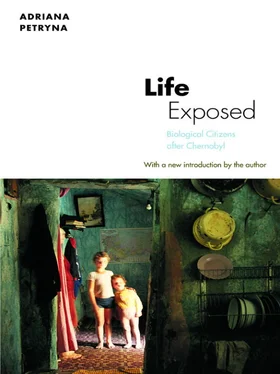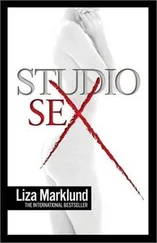In this political economy of Chernobyl-related illnesses, it was common knowledge that a person categorized as “disabled” was far better compensated than a mere “sufferer.” Persons completely outside the system of Chernobyl sufferers knew they had little chance of getting decent social protections from the state. In this economy, scientific knowledge became a crucial medium of everyday life. The effectiveness of relating one’s dose exposures to radiation-related symptoms and experiences and work histories in the Zone determined the position one could occupy in the hierarchy of sufferers, and the extent to which one could wield capital that could further guarantee state protections. Broadly speaking, postsocialist Ukraine presented a unique constellation in which science, state building, and market developments were quite productively intertwined, generating new institutions and social arrangements through which citizenship and ethics were being transformed (see also Biehl 2001).
When I returned to Kyiv for a year’s field research in 1996, my key field site became the Radiation Research Center. [23] This is a pseudonym. I refer to it throughout the book interchangeably as the “Radiation Research Center” and the “center.”
In the Soviet period, the center served as the clinical research division of the All-Union Center of Radiation Medicine. The center’s staff grew from ninety to over thirteen hundred by 1991. These numbers reflect its growth in status as an important social institution; they also illustrate how in the context of economic crisis, government bureaucracies expand rather than contract to provide their own forms of social protection. The center monitors patients with acute radiation sickness and conducts research on the clinical outcomes of human exposures to ionizing radiation. What is most important, it houses the national-level medical-labor committee ( Ekspertiza ), a group of scientists, clinicians, and administrators who are responsible for evaluating the health of Chernobyl Zone workers, resettled families, and inhabitants of contaminated areas. Their job is to evaluate a patient’s level of disability (or loss of labor capacity) and to either verify or disavow the etiology of that disability in Chernobyl-related radiation exposure. Members authorize the Chernobyl connection or “tie” ( sviaz )—a legal document attesting to the link between certain illnesses and radiation exposure. The tie entitles its bearer to social protections in the form of pensions, health care, and even education benefits for children. This package of benefits is, comparatively speaking, much better than average pensions and is therefore very desirable. As of 2000, the state paid an average twelve dollars per month for social insurance. The poverty line was approximately twenty-seven dollars a month. For persons disabled by the Chernobyl accident, for the same period, pension benefits averaged between fifty-four and ninety dollars per month, depending on degree of disability. A sufferer, a person who does not have disability status but has the status of having suffered from the Chernobyl accident, received twenty dollars per month, on average.
Through contacts with politically active groups of disabled Chernobyl Zone workers who frequented clinics, I obtained permission to conduct research in the clinical wing of the center (known as the Clinic). By 1996, the Clinic had become an epicenter of medical-scientific and legal wrangling. Exams, scientific resources, and specialized medical treatment became precious assets for patients who were fortunate enough to be there, helping them qualify for lifetime compensations. I was allowed to observe interactions among physicians, nurses, and patients; to attend decisionmaking meetings related to compensation claims; and to examine current research, particularly in the Clinic’s Division of Nervous Pathologies. This choice of division was intentional on my part. Medical-labor committee members told me that the majority of all disability claims were channeled through neurological wards on account of a variety of nervous system disorders. Yet it was unclear whether these disorders stemmed from social stress owing to the country’s dire economic situation or from Chernobyl radiation exposure, or from some combination of the two. In addition to talking with scientists, health workers, and administrators, I conducted extended interviews with sixty male and female patients (aged 35–55) and reviewed their medical records. I documented the course of their illnesses, diagnosis, and progress in obtaining disability status ( oformyty hrupu , which means “to make the group”). I also worked with three of the Chernobyl funds, tracing the history of their membership and looking into their strategic relationships with the Clinic and the medical-labor committee. A final part of my work involved following the everyday activities of five of the Clinic’s male patients and their wives and children. I was interested in how these men’s induction into this novel political economy of illness was influencing their identities as breadwinners and father figures, as well as affecting their mental health. I was particularly interested in these men’s changing sense of lichnost’, a Soviet concept of personhood that was expressed in individual commitment to work and to the labor collective; and in how married couples were using radiation illness as a means of subsistence in the new economy.
The ways in which scientific and social knowledge circulated at public and private levels also framed aspects of the ethnographic encounter. How people expressed their grief, how the demands of institutional settings shaped their discourse and body language, and how they elicited the responses they needed from technocrats (and their choices of words or silences) all found their place in the political and scientific regime that defined everyday life. People’s actions, politics, and sensibilities were encoded in and restricted by the professional and legal discourses of this rational-technical domain.
At the same time, codes are secrets, signals ensuring privacy; they are systematic abbreviations of human experience. In new technologically mediated contexts, social scientists have voiced concern that our capacities to think critically about moral values are being lost within the expedient languages of bioethics (Churchill 1999:259). What has been called a principlist approach to bioethics is said to work precisely because it is reductive and is widely adaptable to moral problems and dilemmas in a pluralistic society (Callahan 1999:283). One casualty of this standardization of bioethics is knowledge of how certain ethical norms propagate in actual and diverse settings, and of the particularities of local conditions and moral accounts as they may bear on or challenge universalized ethical framings (Kleinman 1999, Cohen 1999).
Such critiques of bioethics challenge ethnographers to restore language adequate to account for contexts where, in the terse words of the director of the Shelter complex, “the value of the human is yet to be determined.” My concerns are not with the rhetorics and images that project the value of the human as universally given but with the mundane office spaces, clinics, wards, and homes where the chances for justice, benevolence, and nonmaleficence routinely disintegrate; where individual accounts of suffering, if they are to be heard at all, must transmogrify into numbers and codes fitting standard categories. [24] Literary critic George Steiner reminds us of the power of words in contexts of violence in which affect and perception are reduced to a code. During his purge in the late thirties, Steiner tells us, Russian writer Boris Pasternak was invited into an auditorium where he was scheduled to undergo a public interrogation in front of a large audience. Before his questioning began, the interrogator told him that he could say one word in his defense. Pasternak uttered the number twenty-five, when, in a most poignant act of defiance, the audience stood up and began to recite a Shakespearean sonnet, number twenty-five, one that Pasternak had translated into Russian. Lecture, Massachusetts Institute of Technology, Department of the Humanities, March 6, 1998.
Читать дальше












